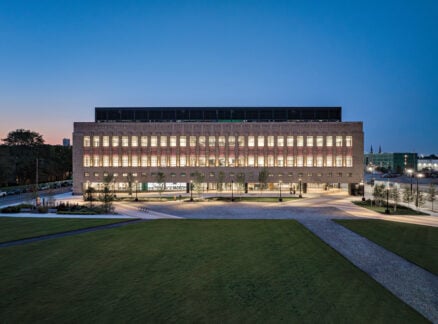
June 6, 2013
Why Carpet Manufacturer Interface Is Embracing Biophilia
In the post–Ray Anderson era, Interface sets itself even higher goals.

Lindsay James has an intriguing new job. She is Interface’s vice president of restorative enterprise. It’s a highfalutin title for what will initially be a two-person team dedicated to transforming the carpet tile manufacturer into—in the words of the company—“an enterprise that restores the environment as well as preserves and protects it.”
This lofty ambition is consistent with the mission put forth by company founder Ray Anderson almost 20 years ago. But it comes weighted with two sobering realities: Anderson’s death two years ago created a kind of unfillable void; and his ultimate goal for the company, Mission Zero, faces profound challenges. Recently, Metropolis executive editor Martin C. Pedersen spoke to James about her new job, biomimicry, and the need for miracles.

Start by telling us what your title actually means.
It’s going back to Ray’s original vision. On the day he kicked off our journey in August 1994, he put forth a vision to put back more than we take from the earth. It’s not just
“do no harm.” He was asking us to leave the world better with every square yard of carpet that we make and sell. That’s what “restorative enterprise” means.
You’re the company’s biomimicry expert. What role will biomimicry play at Interface?
So much of what we’re doing in sustainability is tied to Mission Zero: our promise to eliminate any negative impact we have on the environment. The intention in setting up this new department is to clarify that Mission Zero is a milestone on a journey that we see going beyond 2020. It’s about being restorative at many different levels. Biomimicry can provide a lens for looking at the world around us, and recognizing that nature has already achieved growth that is restorative. It creates the conditions for life, even while it grows.
How does that play out on the plant floor?
That’s what we’re exploring. The first step is embedding biomimicry knowledge across our organization. Next week, we’re doing an ideas-generation workshop with our hourly associates in our manufacturing facilities to introduce them to the idea. One important area we’re looking at is waste, recognizing as a working premise that nature does not have waste. Nature’s waste always has another purpose. So we’ll be taking our associates through a workshop, where they will get outside and explore nature. Once we’ve grounded them in a basic awareness, then we can start to look at ways to eliminate waste in our own manufacturing—whether it’s wasted time, wasted effort, or the physical waste that comes from the carpet scraps. How can we use biomimicry to look at waste from a completely different perspective?
It sounds like you’re interpreting this in the broadest possible way.
Yes. What I like about biomimicry is that it plays at so many different scales. You can use it for products-based innovation. But you can also use it for understanding energy production, information flows, transportation. Then you can scale it out further and think more abstractly, and look at things like organizational design. How do we structure our processes so that we, as a company, are more resilient?
I interviewed Ray several times, and I’d always ask him where the company was in its Mission Zero effort, as it climbed Mount Sustainability. So, where is Interface?
We’re not there yet. It’s very important to recognize that there are some challenges ahead that will be very difficult for us to overcome. We’ll need to approach these challenges from more than just a technological perspective.
It seems like getting the rest of the way will be the hardest part.
It absolutely will be the hardest part. And it will require some miracles. We’ve already generated miracles. Things that we never thought were possible have become possible. Now we’re asking, what are the conditions that we need to create to generate more miracles?
What’s the one big thing you haven’t been able to crack?
I’d say that thermal energy is proving to be very difficult. When we talk about energy for manufacturing, we generally use two types, electricity and heat energy. So figuring out how to produce heat energy without fossil fuels is hard.
Why? Can’t you use solar panels or other renewables?
Those things generate electricity, but our recycling process, for example, relies on heating up these ovens, and you can’t use electricity to get them to the required temperatures, because it’s inefficient. In some of our processes, we use landfill gas as a substitute. This might be the best solution, but not all of our plants are located next to landfills. That’s one of the hardest nuts to crack. One of the global challenges continues to be that there’s no price put on carbon, and so the marketplace isn’t driving solutions. The other big nut to crack is transportation, because it depends so much on the infrastructure around us.
Do you operate hybrid trucks?
We don’t own our own fleets, so that’s out of our grasp. But we do apply a lot of influence, as a purchaser. We have standards in terms of tire inflation, miles per gallon, idling—all those best practices. We’ve been part of the EPA Smartway Transport for as long as it’s been in existence. We’re always looking for creative ways to influence our suppliers, to show them that there’s a better way to do what we call “considered business.”
Your company has made great progress, but as a society we seem stuck. What has to happen for us to move forward?
We have to fundamentally change our relationship with nature. In our highly industrialized society, we’ve become an isolated species. We spend about 95 percent of our time indoors—either in a car, in an office, in our homes, in a shopping mall. We don’t know where our food comes from. And ultimately that means we have no idea how important it is to maintain the basic fabric of our ecological world. And that mindset needs to shift. It’s why biophilic design is so promising, because it can embed this reminder—that we’re a part of the web of life and not apart from it—in every space we create, moving that truth from the abstract and intellectual to the visceral.
Because intellectually, everyone is an “environmentalist,” even oil company executives.
Indeed. Almost everyone wants to do the right thing, but defining that is the tricky part. It begins by acknowledging the various ways that our current system is broken, understanding our contribution to the broken pieces, and working to extract ourselves from the associated negative impacts—ultimately finding ways to be a force of restoration. How many oil executives agree that today’s world is broken? Maybe that’s radical industrialism more than environmentalism, but it’s what we need more of.





